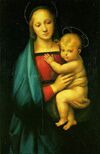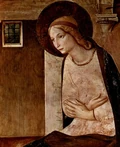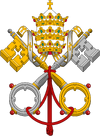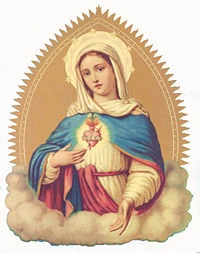
The Blessed Virgin Mary, a traditional Catholic devotional image.
Marian devotions are intercessions to God through the mediation of Mary, the mother of Jesus, or acts of devotions focusing on Mary. Marian devotions are important to the Roman Catholic, Orthodox (both Eastern Orthodox and Oriental Orthodox) and high church Anglican (particularly the Anglo-Catholic) traditions; but most Protestants do not accept them as proper.
For Roman Catholics, the devotional intercession and mediation of the Blessed Virgin Mary involve the Mariological concepts of Mediatrix and Co-Redemptrix, which have not been dogmatically defined, but have received ecclesiastical support and are widely followed by Catholics at large.
Eastern Orthodoxy[]
The Eastern Orthodox Church considers Mary to have been elevated by God to the highest status, above all other creatures, though still only a human being. The Orthodox hymn Axion Estin speaks of Mary as being "More honorable than the cherubim, and more glorious beyond compare than the seraphim". The Orthodox, however, do not accept the Roman Catholic definition of the Immaculate Conception of Mary; in other words, they believe that at her conception, Mary shared in ancestral sin (what is known in the West as 'original sin'), like every other human being, with the exception of Jesus Christ.[1]
Theotokos[]
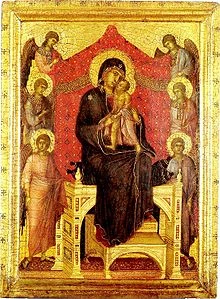
Madonna and Child with Angeles, Duccio, 1282
One title of the Virgin Mary, Theotokos ("the one who gave birth to God"), is very important in Orthodox theology. Since Jesus Christ is understood by Christian orthodoxy as both fully God and fully human, Mary is called "Theotokos" to affirm the fullness of God's incarnation. Near the beginning of the fifth century, the Nestorians denied Mary the title of Theotokos but instead would only call her Christotokos ("the one who gives birth to Christ"), acknowledging only that she gave birth to the humanity of Jesus, but not to his divinity. The Council of Ephesus decreed, in opposition to the Nestorians, that Mary is Theotokos because her son Jesus is one person who is both God and man. As Cyril of Alexandria wrote, "I am amazed that there are some who are entirely in doubt as to whether the holy Virgin should be called Theotokos or not. For if our Lord Jesus Christ is God, how is the holy Virgin who gave [Him] birth, not [Theotokos]?"[2] Thus the significance of the term Theotokos lies more in what it says about Jesus than any declaration about Mary. Mariology is always understood as a branch of Christology.
Within the Orthodox doctrinal teaching on the economy of salvation, Mary's identity, role, and status as Theotokos is acknowledged to be indispensable, and it is for that reason formally defined as official dogma. The only other Mariological teaching so defined is that of her perpetual virginity. Other Marian beliefs (for example, her sinlessness, the circumstances surrounding her conception and birth, her Presentation in the Temple, and her Dormition) are expressed in the Church's liturgy but are not formally defined dogmatically, and belief in them is not a condition for baptism or continued good standing in the church.
Prayer[]
Devotion to Mary is very strong in the Orthodox Church, and she is mentioned numerous times in all of the Divine Services and the Divine Liturgy. The final peitition of each ektenia (litany) ends with an invocation of the Virgin Mary. When a series of troparia are chanted, the final one is often a Theotokion (hymn to the Virgin Mary).
One of the most important Marian devotions is the Akathist to the Theotokos, which is chanted every year during Great Lent, and is frequently chanted throughout the year as a private devotion. Some people chant the Akathist as part of their preparation for Holy Communion.
Roman Catholicism[]
|
General articles |
|
Expressions of devotion |
|
Specific articles |
Marian devotions are highly prominent within the Roman Catholic tradition. Popular Roman Catholic devotions to the Blessed Virgin Mary include the Immaculate Heart of Mary, the Seven Sorrows of Mary and the Seven Joys of Mary. There has also been the long established practice of dedicating side altars in Catholic churches to Mary, often called "Lady Chapels".[3]
Marian devotions build on the established Roman Catholic philosophy for the study and veneration of the Virgin Mary via the field of Mariology.
Holy Rosary[]
The rosary continues to be one of the main Marian devotions among Roman Catholics. In his Apostlic Letter Rosarium Virginis Mariae, Pope John Paul II emphasized the importance of Marian devotions by quoting Saint Louis de Montfort:
- Since Mary is of all creatures the one most conformed to Jesus Christ, it follows that among all devotions that which most consecrates and conforms a soul to our Lord is devotion to Mary, his Holy Mother, and that the more a soul is consecrated to her the more will it be consecrated to Jesus Christ."
Reparations to the Virgin Mary[]
Roman Catholic teachings and traditions includes specific devotions as Acts of Reparation to the Virgin Mary for insults that she suffers. The Raccolta Catholic prayer book (approved by a Decree of 1854, and published by the Holy See in 1898) includes a number of such prayers.[4][5][6]
These devotions and prayers do not involve a petition for a living or deceased beneficiary, but aim to repair the sins of others against the Virgin Mary.
Immaculate Heart of Mary[]
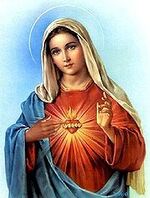
Typical image of the Immaculate Heart of Mary
The Immaculate Heart of Mary (originally The Sacred Heart of Mary) is a devotional name used to refer to the physical heart of Saint Mary as a symbol of the Blessed Virgin's interior life, her joys and sorrows, her virtues and hidden perfections, and, above all, her virginal love for her God, her maternal love for her Son, Jesus, and her compassionate love for all people.
In the twelfth century indications of a regular devotion can be noted in a sermon by St. Bernard (De duodecim stellis), from which an extract has been taken by the Roman Catholic Church and used in the Offices of the Compassion and of the Seven Dolours. Stronger evidences are discernible in the pious meditations on the Ave Maria and the Salve Regina, usually attributed either to St. Anselm of Lucca (d. 1080) or St. Bernard; and also in the large book "De laudibus B. Mariae Virginis" (Douai, 1625) by Richard de Saint-Laurent.
In July 1855, the Congregation of Rites finally approved the Office and Mass of the Most Pure Heart of Mary without, however, imposing them upon the Universal Church. According to the third reported apparition at Fatima, Portugal on July 13, 1917, the Blessed Virgin Mary stated that "God wishes to establish in the world devotion to Her Immaculate Heart" in order to save souls from going into the fires of hell and to bring about world peace. On March 25, 1984, Pope John Paul II fulfilled this request by consecrating of the world to the Immaculate Heart of Mary before the statue of the Virgin Mary of Fatima brought to Saint Peter's Square in the Vatican for the occasion. Again on October 8, 2000, Pope John Paul II made an act of entrustment of the world to the Immaculate Heart of Mary for the new millennium.
Scapular[]
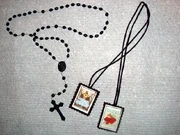
Rosary and Scapular
Although the Scapular may have initially started as a Christocentric devotion, by the end of the Middle Ages it had taken on a distinct Marian tone, to the extent that the Encyclopedia of the Middle Ages called it "one of the main Marian devotions of Christendom".[7]
In the 18th and 19th centuries the Scapular continued to grow, along with the Rosary, as a key Marian devotion and number of Marian scapulars such as the Blue Scapular of the Immaculate Conception, the Scapular of Our Lady of Mount Carmel, the Scapular of the Seven Dolours of Mary, and the Scapular of the Immaculate Heart of Mary were approved. By early 20th century the devotional Scapular had gained such a strong following among Catholics worldwide that the Catholic Encyclopedia of 1914 stated: "Like the Rosary, the Brown Scapular has become the badge of the devout Catholic." [8][9][10][11]
In the early and mid 20th century, the Scapular gained further momentum by being recommended in Marian apparitions such as Our Lady of Fatima. In one of the final reported Fátima appearances on October 13 1917, the Virgin Mary had a Brown Scapular in one hand and a Rosary in the other and reportedly encouraged the praying of the Rosary and the wearing of the Brown scapular.[12][13] In the mid 20th century, the United States "Scapular Magazine" helped enroll one million Americans to pray the Rosary based on the Our Lady of Fatima messages.[14]
The Scapular, along with the Rosary, has become a key Roman Catholic Sacramental for Marian devotions. These two Sacramentals have been supported, encouraged and linked by a number of Catholic figures such as popes, saints and cardinals and specific promises and indulgences have been associated with them.[15][16][17] The Rosary and the devotional scapular continue to be encouraged together as key Marian devotions in the 21st century.[18]
Marian Litanies[]
A Marian litany is a form of prayer to the Blessed Virgin Mary used in church services and processions, and consisting of a number of petitions.
In the Eastern Church litanies are always a part of the official liturgy, and they have at least three different forms: Synaptae (Collect), Ektenie ("intense" prayer of intercession and pardon based in part on Psalm 50)and Aitaesis (intercessory prayer for peace, pardon and protection). Marian litanies are numerous in the Eastern church and may cover a multitude of themes, some dogmatic, others of moral and patriotic character.
In the liturgy of the Western Church the word litany is derived from the Latin litania, meaning prayer of invocation or intercession. It also meant, up to the twelfth century, a procession with intercessory character, also known under the designation of rogation.
The only approved Marian litany in the Western Church is the Litany of the Blessed Virgin Mary, also known as the Litany of Loreto, for its first-known place of origin, the Shrine of Our Lady of Loreto, Italy, where its usage was recorded as early as 1558. The Litany of Loreto was approved in 1587 by Pope Sixtus V.
Protestant views[]
|
Specific views |
| Key prayers & devotions |
|
Ecumenical |
Protestants argue that a Marian devotion is akin to worship, but Christians are to worship God (the Holy Trinity) alone, and not Mary or the saints. Catholics and Orthodox note that this is not the worship that is due to God alone,[19] but merely veneration;[20] however, Protestants do not accept that argument. Protestants are of the opinion that Marian devotion, even if not worship, distracts from attention to God, and devotion to Mary is likely to give rise to tendencies to equate Mary with God. Catholics and Orthodox however would argue that it is the wish of Jesus that Christians should venerate Mary because according to the New Testament she magnifies the Lord, and magnification of her magnifies God (see Mariology). Protestants also feel that many of the Catholic and Orthodox traditions about Mary are not found in the Bible, and therefore should be rejected. Catholics argue that Marian doctrine is implicit in the Bible, as for instance when in the Magnificat, Mary, under the inspiration of the Holy Spirit says, "henceforth, all generations shall call me blessed".[21]
The early reformers, however, believed that Mary should be held in highest reverence, and even advocated the use of the first half of the Ave Maria (that is, "Hail Mary, full of grace, the Lord is with thee. Blessed art thou among women and blessed is the fruit of thy womb.") as a sign of reverence for and devotion to the Virgin.
Moreover, both Luther and Calvin believed the doctrine, now controversial among Protestants, of Mary's perpetual virginity. This belief is even attested to in the Augsburg Confession, one of the foundations of Lutheranism.
See also[]
| Roman Catholic Mariology A series of articles on | |
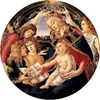
| |
|
Alma Redemptoris Mater | |
- Angelus
- Anglican Marian theology
- Blessed Virgin Mary (Roman Catholic)
- First Saturday Devotions
- Salve Regina (Hail, Holy Queen)
- Hail Mary
- History of Roman Catholic Mariology
- Holy Family (Holy Family Prayer)
- Holy Name of Mary
- Islamic view of Virgin Mary
- Joy of all who Sorrow
- List of prayers – Christian prayers
- Litany of the Blessed Virgin Mary
- Marian doctrines of the Catholic Church
- Mary (mother of Jesus)
- Mary garden
- Mary Untier of Knots
- Mary, Mother of Grace
- Memorare (Remember, O Most Gracious Virgin Mary)
- Our Lady of Westminster
- Power of Christian prayer
- Prayer to Saint Joseph
- Swapping of the handkerchief
- The Glories of Mary
- Theotokos
- Theotokos
- Three Hail Marys
- Titles of Mary
References[]
- ↑ Antony Hughes, M.Div., 2004, Ancestral Versus Original Sin: An Overview with Implications for Psychotherapy. Accessed 2007-12-28.
- ↑ Cyril of Alexandria, Epistle 1, "To the Monks of Egypt"; Migne, Patrologia Graecae, 77:13B
- ↑
 "Devotion to the Blessed Virgin Mary". Catholic Encyclopedia. New York: Robert Appleton Company. 1913. http://en.wikisource.org/wiki/Catholic_Encyclopedia_(1913)/Devotion_to_the_Blessed_Virgin_Mary.
"Devotion to the Blessed Virgin Mary". Catholic Encyclopedia. New York: Robert Appleton Company. 1913. http://en.wikisource.org/wiki/Catholic_Encyclopedia_(1913)/Devotion_to_the_Blessed_Virgin_Mary.
- ↑ Ann Ball, 2003 Encyclopedia of Catholic Devotions and Practices ISBN 087973910X
- ↑ Catholic Encyclopedia http://www.newadvent.org/cathen/12620a.htm
- ↑ Joseph P. Christopher et al., 2003 The Raccolta St Athanasius Press ISBN 978-0970652669
- ↑ Andre Vauchez, 2001, Encyclopedia of the Middle Ages, Fitzroy Dearborn Press ISBN 9781579582821 page 1314
- ↑ Catholic Encyclopedia [1]
- ↑ EWTN on the History of the Brown Scapular [2]
- ↑ Henry Charles Lea, 2002, A History of Auricular Confession and Indulgences in the Latin Church, Adamant Media Corp. ISBN 1402161085 page 498
- ↑ Mark Forster, 2001, Catholic Revival in the Age of the Baroque Cambridge Univ Press ISBN 0521780446 page 145
- ↑ Thomas W. Petrisk, 1998, The Fatima Prophecies, St. Andrews Press, ISBN 9781891903304 page 345
- ↑ Lucia Santos, 1976, Fatima in Lucia's Own Words, Ravengate Press ISBN 0911218106
- ↑ Eli Lederhendler, 2006 Jews, Catholics, and the Burden of History Oxford University Press ISBN 0195304918 page 98
- ↑ Vatican website for Pope Paul VI's Apostolic Constitution Indulgentiarum Doctrina [3]
- ↑ Thomas Petrisko, 2000, Inside Heaven and Hell, St. Andrews Press ISBN 9781891903236 page 105
- ↑ Pope John Paul II, 1996, Gift And Mystery, Doubleday Books ISBN 9780385409667 page 28
- ↑ Zenit News 2008 Cardinal Urges Devotion to Rosary and Scapular, [4]
- ↑ Greek: latria
- ↑ dulia or proskinesis
- ↑ Luke 1:48)
This article incorporates text from the Catholic Encyclopedia of 1913, a publication now in the public domain.
| ||||||||||||||||||||
| This page uses content from the English Wikipedia. The original article was at Marian devotions. The list of authors can be seen in the page history. |
